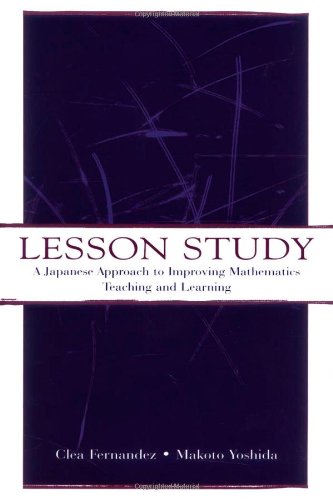

Most ebook files are in PDF format, so you can easily read them using various software such as Foxit Reader or directly on the Google Chrome browser.
Some ebook files are released by publishers in other formats such as .awz, .mobi, .epub, .fb2, etc. You may need to install specific software to read these formats on mobile/PC, such as Calibre.
Please read the tutorial at this link. https://ebooknice.com/page/post?id=faq
We offer FREE conversion to the popular formats you request; however, this may take some time. Therefore, right after payment, please email us, and we will try to provide the service as quickly as possible.
For some exceptional file formats or broken links (if any), please refrain from opening any disputes. Instead, email us first, and we will try to assist within a maximum of 6 hours.
EbookNice Team

Status:
Available0.0
0 reviews
ISBN 10: 0805839615
ISBN 13: 9780805839616
Author: Clea Fernandez, Makoto Yoshida
Lesson study is a popular professional development approach in Japan whereby teachers collaborate to study content, instruction, and how students solve problems and reach for understanding in order to improve elementary mathematics instruction and learning in the classroom. This book is the first comprehensive look at the system and process of lesson study in Japan. It describes in detail the process of how teachers conducted lesson study--how they collaborated in order to develop a lesson, what they talked about during the process, and what they looked at in order to understand deeply how students were learning. Readers see the planning of a mathematics lesson, as well as how much content knowledge the teachers have. They observe students' problem solving strategies and learn how Japanese teachers prepare themselves to identify those strategies and facilitate the students' discussion. Written for mathematics teachers, educational researchers, school administrators interested in teachers' professional development, and professional developers, this landmark volume provides an in-depth understanding of lesson study that can lead to positive changes in teachers' professional development and in teaching and learning in the United States.
1 Introduction
Why Study Lesson Study?
Book Overview
The Organization of This Book
A Note on Data Sources
2 An Overview of Lesson Study
The Lesson Study Process
Step 1: Collaboratively Planning the Study Lesson
Step 2: Seeing the Study Lesson in Action
Step 3: Discussing the Study Lesson
Step 4: Revising the Lesson (Optional)
Step 5: Teaching the New Version of the Lesson (Optional)
Step 6: Sharing Reflections About the New Version of the Lesson
Venues for Conducting Lesson Study
The Organization of Konaikenshu-Based Lesson Study
A Brief History of Lesson Study
3 Lesson Study at Tsuta Elementary School
Konaikenshu in the Western Region of Hiroshima
About Tsuta Elementary School
Lesson Study at Tsuta Elementary School between 1991 and 1994
Summary of 1991–1992 Konaikenshu Activities at Tsuta
Summary of 1992–1993 Lesson Study Activities at Tsuta
Summary of 1993–1994 Lesson Study at Tsuta
4 Illustrating the Lesson Study Through the Work of 5 Tsuta Teachers
The Lower Grade Participants
The Organization of the Lower Group's Work
5 Drawing Up a Preliminary Lesson Plan
The Lesson Plan: A Complex Three-Part Document
Section 1: An Introduction to the Lesson Plan
Section 2: Information About the Unit
Section 3: Information About the Lesson
6 Refining the Lesson Plan
What Problems Should Students Work on?
What Manipulatives should Students be Provided?
How will Students be Encouraged to Discuss their Work?
How to Conclude the Lesson?
7 Preparing to Teach the Study Lesson
Touching up the Lesson Plan
Creating Materials and Rehearsing
8 Teaching the Study Lesson
Grasping the Problem Setting
Presentation of the Problem Format
1 Present the Problem Format and Use It on Previously Learned Subtraction Situations
2 Using the Format to Set Up the Main Problem of the Lesson
Solving the Problem
1 Thinking About Writing an Expression(Shiki)
2 Grasping the Topic
3 Solving the Problem Individually
Polishing And Presenting Individual Solution Methods (NERIAGE)
Sachiko's Solution
Ken's Solution
Akira's Solution
Summary and Announcement for the Next Lesson
9 Discussing How to Improve the Study Lesson
Improving the Use of Time in ihe Lesson
Redesigning the Handout
Clarifying the Focus on Subtraction
Refining the Manipulative for the Lesson
Specifying Wording and Questions (Hatsumon)
10 The Revised Lesson Plan
11 Teaching the Revised Lesson
Grasping the Problem Setting
Presentation of the Problem Format
1 Presenting the Format and Using it on Previously Learned Subtraction Situations
2 Using This Format to Set Up the Main Problem of the Lesson
Solving the Main Problem
1 Thinking About Writing an Expression (Shiki)
2 Understanding What the Problem Is Asking
3 Solving the Problem Individually
Polishing and Reporting Individual Solution Methods
Kyoko's Solution
Shigeru's Solution
Emi's Solution
Yasuko's Solution
Summary and Announcement of the Next Lesson
12 Sharing Reflections About the Study Lesson
Mr. Yamasaki's Opening Remarks
Ms. Tsukuda's Self-Evaluation of the LESSON
Group Discussion of the Lesson
Mr. Saeki's Comments and Suggestions
Closing Remarks From Mr. Yamasaki
13 Follow-Up Activities: Sharing and Reflecting
Tsuta Hosts A Lesson Study Open House
Preparing for the Event
Results of the Lesson Study and Other Issues
Hosting the Event
Registration
Presenting the Study Lessons
Postlesson Conference
Lunch Break
All Teacher Meeting
follow-Up Celebration
Year-End Reflection On KONAIKENSHU
14 Strategies for Avoiding Isolation in Order to Enhance Lesson Study
The Outside Advisor Serves to Create Links Across Lesson Study Groups
Research Bulletins—A Vehicle for Sharing Lesson Study Insights and Strategies
Lesson Study Groups Connect Through the Members they Share
Regional Study Groups
Teacher Clubs
A System of Regular Teacher Rotations Allows Lesson Study Groups to Learn From Each Other
15 Conclusion
What do Teachers Stand to Gain From Engaging in Lesson Study?
The Role of Tsuta Teachers in Enhancing and Shaping their Lesson Study Experience
Treating Lesson Study as Directed and Systematic Inquiry
The Tsuta Teachers Worked Toward Designing a Specific Type of Lesson
What Important Lessons can we Draw from Japane
Tags: Clea Fernandez, Makoto Yoshida, Lesson, Japanese